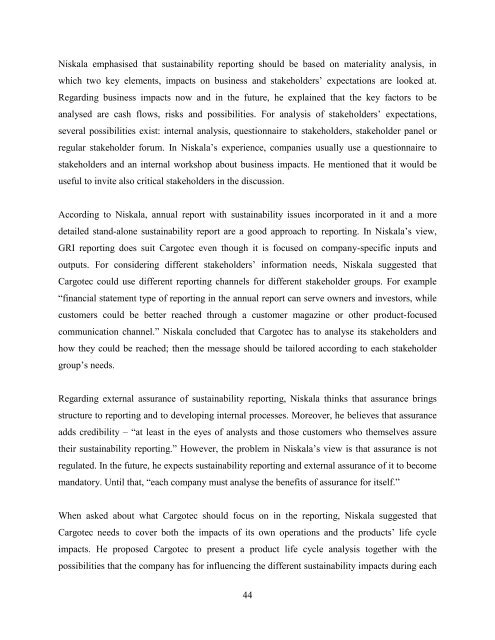Developing sustainability reporting - Case Cargotec - Aaltodoc
Developing sustainability reporting - Case Cargotec - Aaltodoc
Developing sustainability reporting - Case Cargotec - Aaltodoc
You also want an ePaper? Increase the reach of your titles
YUMPU automatically turns print PDFs into web optimized ePapers that Google loves.
Niskala emphasised that <strong>sustainability</strong> <strong>reporting</strong> should be based on materiality analysis, in<br />
which two key elements, impacts on business and stakeholders’ expectations are looked at.<br />
Regarding business impacts now and in the future, he explained that the key factors to be<br />
analysed are cash flows, risks and possibilities. For analysis of stakeholders’ expectations,<br />
several possibilities exist: internal analysis, questionnaire to stakeholders, stakeholder panel or<br />
regular stakeholder forum. In Niskala’s experience, companies usually use a questionnaire to<br />
stakeholders and an internal workshop about business impacts. He mentioned that it would be<br />
useful to invite also critical stakeholders in the discussion.<br />
According to Niskala, annual report with <strong>sustainability</strong> issues incorporated in it and a more<br />
detailed stand-alone <strong>sustainability</strong> report are a good approach to <strong>reporting</strong>. In Niskala’s view,<br />
GRI <strong>reporting</strong> does suit <strong>Cargotec</strong> even though it is focused on company-specific inputs and<br />
outputs. For considering different stakeholders’ information needs, Niskala suggested that<br />
<strong>Cargotec</strong> could use different <strong>reporting</strong> channels for different stakeholder groups. For example<br />
“financial statement type of <strong>reporting</strong> in the annual report can serve owners and investors, while<br />
customers could be better reached through a customer magazine or other product-focused<br />
communication channel.” Niskala concluded that <strong>Cargotec</strong> has to analyse its stakeholders and<br />
how they could be reached; then the message should be tailored according to each stakeholder<br />
group’s needs.<br />
Regarding external assurance of <strong>sustainability</strong> <strong>reporting</strong>, Niskala thinks that assurance brings<br />
structure to <strong>reporting</strong> and to developing internal processes. Moreover, he believes that assurance<br />
adds credibility – “at least in the eyes of analysts and those customers who themselves assure<br />
their <strong>sustainability</strong> <strong>reporting</strong>.” However, the problem in Niskala’s view is that assurance is not<br />
regulated. In the future, he expects <strong>sustainability</strong> <strong>reporting</strong> and external assurance of it to become<br />
mandatory. Until that, “each company must analyse the benefits of assurance for itself.”<br />
When asked about what <strong>Cargotec</strong> should focus on in the <strong>reporting</strong>, Niskala suggested that<br />
<strong>Cargotec</strong> needs to cover both the impacts of its own operations and the products’ life cycle<br />
impacts. He proposed <strong>Cargotec</strong> to present a product life cycle analysis together with the<br />
possibilities that the company has for influencing the different <strong>sustainability</strong> impacts during each<br />
44
















